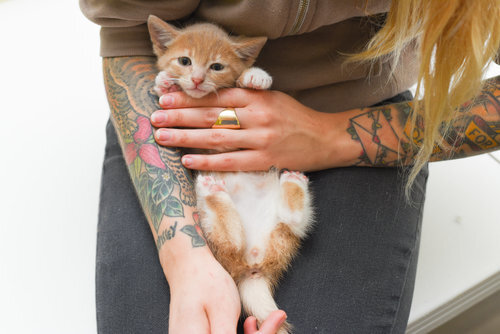Pectus Excavatum in Kittens
What is Pectus Excavatum?
Pectus excavatum, also called funnel chest, is a congenital condition causing the sternum and rib cage to be misshapen and sunken into the chest. Although kittens with this condition may have few complications during the first weeks of life, as the kitten grows, pectus excavatum can lead to serious issues with cardiac and respiratory function if there is not enough space for the heart and lungs to grow.
You may suspect that a kitten has pectus excavatum if you notice the following symptoms:
Irregularly flat or small chest
Irregular shape to the ribs
Chest seeming to dip inwards with each breath
Increased respiration
Kittens suspected to have pectus excavatum should see a veterinary specialist as quickly as possible.
Early Intervention is Critical
A radiograph of a kitten with pectus excavatum
If you believe that your kitten might have pectus excavatum, you should make an appointment with an orthopedic specialist or experienced veterinarian right away. The veterinarian will take radiographs of the kitten’s chest to determine the extent of the condition, and to decide whether or not surgery will be necessary. In some mild cases, cats can live long healthy lives without surgery, but in many cases, they will need surgery in order to survive past kittenhood. Time is of the essence in these cases, so it is recommended to schedule an appointment as quickly as possible.
Surgery is most effective and successful in young kittens whose bones are still pliable—ideally between three weeks and three months of age. While older kittens can still receive successful treatment, their surgeries can be more complicated and risky. Talk to a veterinarian about the best treatment option for your kitten given her age and the severity of her symptoms.
Pectus Excavatum Surgery
A three week old kitten receives surgery for pectus excavatum
A ten week old kitten wears a chest plate a week after surgery
Surgery for pectus excavatum involves re-shaping the ribs and expanding the chest to allow more room for the lungs and heart to grow and expand. In order to do this, the veterinarian will anesthetize the kitten, then sew into the bones and pull the ribs forward, attaching them to an external chest plate on the outside of the kitten’s body. After surgery, the chest plate will remain on the kitten for three to four weeks, stabilizing the bones in a proper position.
Kittens have a high likelihood of full recovery with surgery. However, potential risk of this surgery is re-expansion pulmonary edema, a life-threatening condition that can occur when the lungs re-expand too quickly. Kittens should be monitored closely for 24 hours after surgery, when this is most likely to occur.
Recovering From Surgery
After surgery, the kitten should stay with the veterinarian for several hours to ensure that there are no post-operative complications. Once she has been released, you should follow your veterinarian’s instructions, which may include:
Caregivers can keep the chest plate clean and secure with gauze and vet wrap
In kittens under 2 pounds, a sock can be cut to create a simple recovery shirt.
Limiting play and activity for one week
Providing pain management or other oral medications
Padding the chest plate with a sterile cotton gauze
Gently wrapping the kitten in gauze, vet wrap, or a comfy-fitting handmade sock shirt
Keeping the area clean with a sterile saline flush
Returning for radiographs in three to four weeks
After several weeks, your kitten’s chest should be stable enough for your veterinarian to cut the stitches and remove the chest plate. Most kittens will live normal, healthy lives after recovery!
You’ve Got This!
Caring for a kitten with pectus excavatum is a very rewarding experience. With surgery, kittens can quickly feel better — and you’ll feel wonderful knowing that you gave them a chance at a long, happy life!









